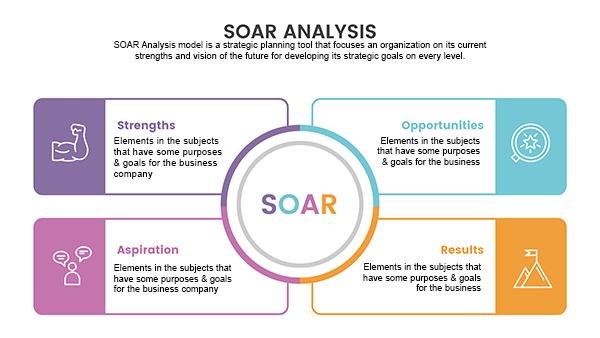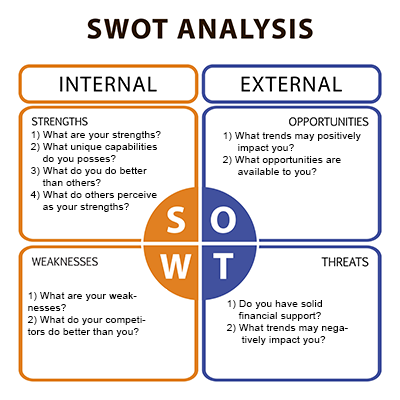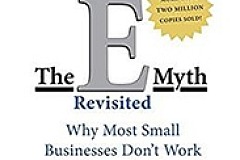Whether your business is large or small, strategic planning is crucial for success. Unfortunately, far fewer small businesses use strategic planning than larger firms because traditional planning approaches have done little to help them find the keys that unlock breakthroughs in growth and profitability.
The SWOT (strengths, weaknesses, opportunities, and threats) analysis has been a go-to planning framework since the 1960s and is widely used in big business. For years, there has been no comparable tool available for the newer, smaller business.
But that has changed. A tool called SOAR analysis is gaining traction among small businesses due to its forward-thinking and strength-focused approach. In this article, we will explore the benefits of SOAR analysis and compare it to SWOT and explain another popular tool – the SMART framework – to understand how small businesses can leverage these three tools for fast progress and growth.
Understanding the SOAR Analysis
SOAR is an acronym for Strengths, Opportunities, Aspirations, and Results. Unlike the SWOT analysis, which emphasizes weaknesses and threats, the SOAR analysis focuses on a business's strengths and how they can be leveraged to seize opportunities. This positive evaluation approach allows businesses to build on their strengths rather than fixating on weaknesses. Let's delve deeper into each component of the SOAR analysis.

Strengths: Harnessing What You Do Best
The first step in a SOAR analysis is identifying the strengths of your organization. These are the areas where your business excels and has a competitive advantage over others. It could be your unique selling point, valuable know-how, or critical assets. By determining your strengths, you can leverage them to capitalize on opportunities and drive growth.
Opportunities: Expanding Your Horizons
Opportunities are external factors that can contribute to the success of your business. They can arise from market trends, changes in the industry, or unfulfilled customer needs. Identifying these opportunities allows you to explore new markets, develop innovative products or services, and expand your customer base. By aligning your strengths with these opportunities, you can create a winning strategy for growth.
Aspirations: Setting Inspiring Goals
Aspirations are the visions and goals that inspire your organization. They go beyond your overall vision and focus on specific objectives that are challenging and meaningful. By setting aspirations, you define what you want to achieve, what your future organization should look like, and how you can make a difference. Aspirations provide direction and motivation for your business, guiding you toward your desired future.
Results: Tracking Progress and Success
Results are the measurable outcomes that indicate whether you have achieved your aspirations. They serve as benchmarks for progress and help you track the effectiveness of your strategy. By defining specific metrics and milestones, you can monitor your performance and make necessary adjustments along the way. Results keep your business accountable and ensure that you are on the right path towards your goals.
Advantages of the SOAR Analysis
The SOAR analysis offers several advantages that make it a valuable tool for small business growth. Consider these attributes:
- Forward-looking and Strength-focused. Unlike the SWOT analysis, which dwells on weaknesses and threats, the SOAR analysis is future-oriented and focuses on leveraging strengths. It encourages businesses to build on what they are already doing well, fosters a positive mindset, and drives growth.
- Tangible Goals and Action-Oriented Approach. The SOAR analysis incorporates tangible goals and action plans into the strategic planning process. It provides a clear roadmap for achieving aspirations and results. By defining specific objectives and actionable steps, businesses can effectively execute their strategy and make progress toward their goals.
- Guidance for Future Direction. The SOAR analysis helps businesses identify their core strengths, explore opportunities, and set inspiring goals. It provides guidance for the future direction of the organization, aligning efforts and resources toward a common vision. With a clear sense of purpose, businesses can make informed decisions and navigate the competitive landscape more effectively.
Disadvantages of the SOAR Analysis
While the SOAR analysis offers numerous benefits, it also has a few limitations:
- Overlap with Overall Vision. One potential disadvantage of the SOAR analysis is the overlap between aspirations and the overall vision of the organization. Aspirations may seem redundant if your business already has a well-defined vision. It is important to ensure that aspirations complement and enhance your overall vision, rather than duplicating it.
- Potential for Wrong Goals. Another disadvantage of the SOAR analysis is the possibility of setting the wrong goals. Since the analysis focuses on strengths and opportunities, there is a risk of overlooking potential weaknesses and threats. It is crucial to strike a balance between leveraging strengths and addressing areas of improvement to ensure a comprehensive and effective strategy.
Using SWOT with SOAR to Avoid Its Shortcomings
 SWOT analysis looks at Strengths, Weaknesses, Opportunities, and Threats. By identifying and analyzing these elements, you can gain valuable insights into your business's internal strengths and weaknesses, as well as external opportunities and threats in the market.
SWOT analysis looks at Strengths, Weaknesses, Opportunities, and Threats. By identifying and analyzing these elements, you can gain valuable insights into your business's internal strengths and weaknesses, as well as external opportunities and threats in the market.
Let's dive deeper into each component of SWOT analysis:
- Strengths. These are the internal factors that give your business a competitive advantage. They can include things like a strong brand reputation, unique selling proposition, talented employees, or advanced technology.
- Weaknesses. These are the internal factors that hinder your business's growth or competitiveness. They can include things like poor customer service, outdated technology, lack of market knowledge, or limited financial resources.
- Opportunities. These are the external factors that have the potential to positively impact your business. They can include things like emerging market trends, new customer segments, strategic partnerships, or advancements in technology.
- Threats. These are the external factors that pose challenges or risks to your business. They can include things like intense competition, economic downturns, changing consumer preferences, or government regulations.
By conducting a thorough analysis of these components, you can gain a holistic understanding of your business's current state and develop strategies to capitalize on your strengths, address weaknesses, seize opportunities, and mitigate threats.
Benefits of Conducting a SWOT Analysis
Now that you understand what SWOT analysis entails, let's explore the benefits it offers to your business:
- Strengths and Opportunities. By focusing on what you do better than anyone else while considering the realities of competition and resources, you identify areas where you can leverage your strengths and opportunities, while minimizing the impact of weaknesses and threats. It provides a structured framework for making informed decisions and setting realistic goals.
- Competitive Advantage. By understanding your business's unique strengths and opportunities, you can differentiate yourself from competitors and stand out in the market. This knowledge allows you to position your products or services in a way that appeals to your target audience and attracts more customers.
- Risk Management. SWOT analysis helps you identify potential threats and risks to your business. By being aware of these factors, you can develop contingency plans and take proactive measures to minimize their impact. This proactive approach allows you to navigate challenges more effectively and ensure the long-term stability of your business.
- Resource Allocation. SWOT analysis helps you allocate your resources effectively. By identifying areas where you need to invest more resources to address weaknesses or capitalize on opportunities, you can optimize your budget and manpower allocation, maximizing your business's overall efficiency and profitability.
In summary, conducting a SWOT analysis provides valuable insights into your business's internal and external factors, enabling you to develop a strategic plan, gain a competitive advantage, manage risks, and allocate resources wisely.
Combining SWOT and SOAR to Avoid Weaknesses of Both
Both SWOT and SOAR analyses have their unique advantages, but when combined, they create a powerful synergy that can drive business success. By using SWOT analysis to identify and address weaknesses and threats, and SOAR analysis to leverage strengths, opportunities, aspirations, and results, you can develop a well-rounded strategic plan that maximizes your business's potential.
For example, let's say your SWOT analysis reveals that your business has a strong brand reputation and talented employees (strengths), but you are facing intense competition and changing consumer preferences (threats). By combining this information with SOAR analysis, you can focus on innovative marketing strategies (opportunity) that align with your aspirations for growth and achieve measurable results.
SOAR vs. SMART: Implementing Your Plan
Far too often, even great plans were never put into practice and gathered dust instead of growing a great business. Why is this and how do you avoid it? In a word, you must have a system that lets you “eat the whale one spoonful at a time.” That is, you need a way to turn big ideas into a series of steps you can take, measure, and accomplish in a short time frame, which when repeated over time, result in accomplishing your plan. That process is done using goal setting, which breaks up your big goals into those smaller parts that you can assign people and resources to in order to accomplish them.
This process is known as the SMART framework. Let's compare these two approaches to understand how small businesses can benefit from each.

The SMART Framework
The SMART framework stands for specific, measurable, achievable, relevant, and timebound. It is a goal-setting technique that helps businesses define clear and actionable objectives.
The SMART framework is widely used for setting short-term goals, tracking progress, and ensuring accountability. It is suitable for businesses that have a well-established vision and are looking for a structured approach to goal setting.
How Small Businesses Can Make Fast Progress with SOAR and SMART
Small businesses can leverage both the SOAR analysis and the SMART framework to make fast progress and drive growth. Here's how:
- Start with a SOAR Analysis. Begin by conducting a SOAR analysis to identify your strengths, explore opportunities, set inspiring goals, and define measurable results. This will provide a solid foundation for your strategic planning process.
- Conduct a SWOT Analysis to Avoid SOAR’s Shortcomings. You’ll gain a deeper understanding of your business advantages and shortcomings.
- Integrate SOAR and SMART. Integrate the insights from your SOAR and SWOT analyses with the structured goal-setting approach of the SMART framework. Align your strengths and opportunities with SMART goals to create a comprehensive and actionable strategy for your business.
- Regularly Review and Adjust. Continuously review your progress, measure the results, and adjust your strategy as needed. Both the SOAR analysis and the SMART framework are iterative processes that require constant evaluation and refinement.
By combining the forward-thinking approach of the SOAR analysis with the structured goal setting of the SMART framework, small businesses can achieve fast progress and drive sustainable growth. These tools provide a holistic approach to strategic planning, enabling businesses to leverage their strengths, explore opportunities, set inspiring goals, and track measurable results.
Wield all Three Tools!
The SOAR analysis and the SMART framework are valuable tools for small business growth and including a SWOT analysis helps buttress shortcomings of SOAR alone.
While the SOAR analysis focuses on strengths, opportunities, aspirations, and results, the SMART framework gives you the key to implementing your plan effectively by deconstructing your plan into a series of steps. It emphasizes setting small specific, measurable, achievable, relevant, and timebound goals to keep your team focused on what is most important, give you a way to measure progress, and know that each step is accomplished on time.
By integrating these approaches, small businesses can create a robust and actionable strategy that propels them towards success. Knowing what you now know, you can embrace the power of strategic planning and unlock the full potential of your business regardless of how small your company may be.
Get Assistance Applying These in Your Business
Two heads, particularly when one is an “outsider,” are definitely better than doing it alone. Outsiders don’t know what you do and their questions and insights will dramatically improve your results.
Want to explore further? Have questions? – Get in touch and let’s set up a time to talk. Brian Tracy USA: 877.433.6225 Email Me feedback@focalpointcoaching.com














